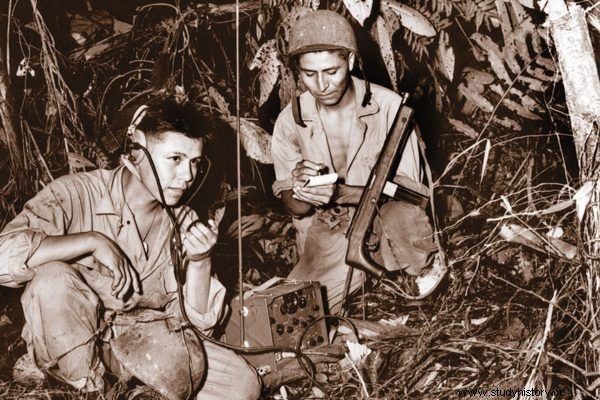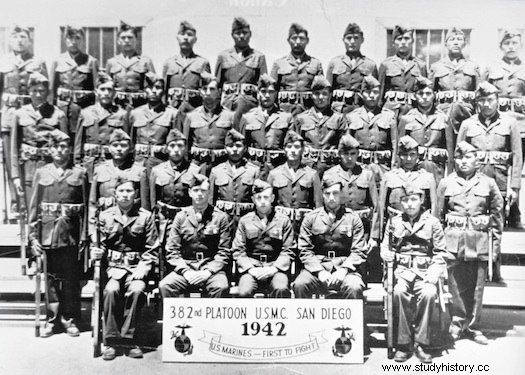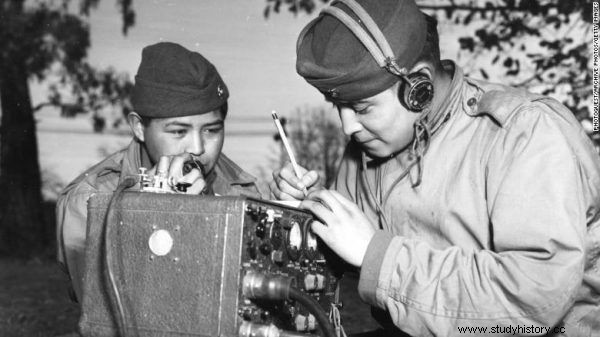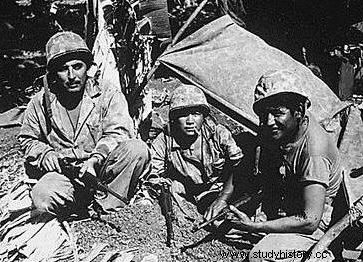The US Army used perfect ciphers during the Second World War. Instead of laboriously substituting numbers instead of letters or carrying heavy encryption machines to the front lines - soldiers who spoke an incomprehensible language were incorporated into the communications units. There were… Indians sitting by the radio stations.
The idea of using an incomprehensible language for secret communication is as old as the world. For example, children use it by communicating in a language or slogans that adults do not understand. It was perfectly described by Mikołaj Łoziński in his novel, popular in recent months. "Stramer" . Growing up boys from the Jewish family of Stramers from Tarnów use the abbreviation "PKP" in their conversations at the table, which means "will you let me loose?" The answer is, for example, "ATR" - "but only once."
This child code is fairly easy to crack, especially for parents who know their children well. In a war, security of communications has to be better. The Americans saw it when they landed in Europe in 1918 to support the troops of the Entente and to bring peace to the "Old Continent" ...
When the American Expeditionary Forces finally went to fight the Germans, it turned out that they were doing exceptionally well, fiercely defending themselves and only yielding after many days of bloody battles. There was no doubt that they knew the American agenda, because they were always where they were not supposed to be.

Some of the Indian code talkers were very young
It turned out that they cracked American ciphers, decrypted and translated American radio reports into German, and they eavesdropped phone calls! They ran almost as smoothly as Google! The orders and reports sent by the Americans were read at the same time on both sides of the front. If the next big offensive was to be successful, something had to be done about it.
Nobody understands the Choktavas
The solution was found by Cpt. E.W. Homer from the 141st Infantry Regiment, adjutant of one of the higher commanders, who - returning from another nervous conference - heard two soldiers talking in the trench:Salomon Lewis and Mitchell Bobb. Homer realized his people did not speak American. They came from the Indian Choctava tribe of Oklahoma and used their national language, understood only by their fellow tribesmen and territorially closest neighbors. The rules and vocabulary of the Choktava language had not been written down by that time so there was no way any white man would understand what the Indians were talking about.
It turned out that there were eight more Choctava Indians in Lawrence's regiment, who were immediately taken from the line and incorporated into communications units. Thanks to this, communication was completely secured against the enemy's listening. The first time the language of the Choktavas was used "in combat" on October 26, 1918. A captured German officer confirmed that their radio recognition "spread" in the last hours, because German linguists could not even identify the language they were listening to.
The Choctavas were not the only Indian ciphers of the U.S. Army at the time. Although World War I was coming to an end, the fighting had just culminated and the Entente troops were conducting deep offensives that were to persuade Germany to surrender. The Americans were also supported at the front by a group of Cherokee Indians who were responsible for the communication of the 30th Infantry Division fighting, incl. in the Second Battle of the Somme. Indians of the Ponca tribe, various tribes of the Sioux (Lakota Sioux), Pawnee (Paunisi), Osage (Osajowie), Meskwaki and Comanche tribes also served as ciphers.
Time of machine ciphers
In the interwar period, the merits of the Indians (now it is recommended to use the terms "Native Americans," First Nations "or similar - editor's note) - at the front were shrouded in secrecy, and the coders returned to the reservations, where - in most cases - they lived in extreme misery. The US government continued to pursue an effective anti-Indian policy by limiting the areas of reservations, encouraging Indians to move to cities and abandon the customs and traditions of their ancestors. The Indians were harassed and discriminated against at every turn and everywhere.

The first branch of Navajo Code Talkers
This does not mean that everyone has forgotten their war merits. They were remembered, for example, by… the Germans. German Intelligence identified the I-war American encryption method as being native to the Native American language. A group of German linguists and anthropologists were sent to the USA to visit the Indian tribes and try to learn about their culture, and above all their language. However, there were many tribes, and their languages differed greatly from one another. German linguists and anthropologists may have learned a few Native American languages, but there were hundreds more to "work out".
At the same time, everything indicated that linguistic methods in cryptology are already being abandoned. In the 1920s, mathematical methods began to be used. The most developed countries, which were soon to face each other in World War II, switched to machine encryption systems, in which messages were coded using complex electromechanical machines, such as the German Enigma, British Typex, or the American Hagelin.
As we know, the method of reading machine-encrypted messages was first invented by Polish mathematicians: Marian Rejewski, Jerzy Różycki and Henryk Zygalski who in December 1932 broke the principle of operation of the German Enigma. They did it using mathematical methods and until 1938, they read the German dispatches with breaks. In 1939, with the inevitable outbreak of war, they handed over their scientific discoveries to their allies:French and English intelligence.
The only condition set by the Poles was to keep the fact of breaking the Enigma in absolute secrecy. The British managed to do it until the end of the war, and even longer, and it was for these reasons that the operation of the Enigma decryption and the transmission of reports from this source was given the code name "Ultra" (for ultra secret - editor's note).
Japanese know English
The American army and navy also used electromechanical machines similar to Enigma to encrypt messages (it was, for example, M-209 - Hagelin's machine - editor's note). However, since the Americans knew about the British successes in breaking the Enigma, the M-209 was not considered completely safe. The speculations of the Americans were confirmed by the Germans, who, after America joined the war, were able to break messages encrypted with the M-209. The American staff members assumed that the Japanese could do it, too, especially since they had many skilled cryptologists.
Japan also had an "army" of hard-working citizens who knew the Anglo-American language perfectly. Many Japanese took advantage of the interwar period of peace and relaxation and went on scholarships to American universities. E.g. Admiral Isoroku Yamamoto himself, commander of the Japanese fleet, spoke perfect English because he graduated from ... language studies at Harvard University and for nine years he studied and worked in the USA.

Indian coders influenced the fate of World War II
Proven methods have been used to protect against a possible Japanese hacking into the American cipher system. The originator of this solution was an engineer from Los Angeles - Phillip Johnston, raised in ... an Indian reservation. He was the son of a Protestant missionary, grew up among the Navajo Indians and spoke their language.
At the same time, Johnston was a World War I veteran and knew about the use of the Choctava language in this conflict. A few weeks after the attack on Pearl Harbor, he made his proposal to the army and, after some resistance from the hardliner staff, was finally heard.
In early 1942, the army conducted tests in which Navahs who spoke fluent English took part. They proved that under combat conditions, they could send any radio messages in their own language and translate them into English much faster than machines could do. It took them 20 seconds to deliver one message while the encryption and machine decryption took as long as half an hour.
Navahos go to the front
As the staffs realized that the idea of using the Indian language in radio communications was no longer top secret, the knowledge of the Navajo language among people outside the tribe was examined. It turned out that only 28 whites speak (at varying levels) all of whom were on US territory at the time. Plus, neither was German or Japanese! This ensured that this encryption method was fully "tight".
An important issue was also the size of the Navajo nation, which survived as many as 50,000, so the tribe had a large recruitment potential. The ciphers had to not only speak English, but also be physically fit and undergo normal military training, like other recruits going to the front. An additional argument in favor of choosing the Navajo language was its complexity.
Sounds in the Navajo language must be played with meticulous care. The pronunciation of those who learned the language as adults will be evil and sluggish to the true Navajo ear. The roots of many verbs in the Navajo language change depending on the objects they refer to. One core is used to describe long and hard objects (pencil, stick), another for thin and flexible objects (snake, thong). With one word, a few syllables and the right intonation you can express a lot, a Navajo verb is like a miniature poem
- wrote the anthropologist Clyde Kluckholn.

Navaho ciphers
There were only 30 first Navajo ciphers, but when they proved successful, another 420 were called in. Combat training, as well as communication and cipher training, took place at Camp Pendleton near San Diego, after which they set off for the Pacific islands. They underwent their baptism of fire in the fighting in Guadalcanal, which was a bloodbath for the Americans. After the fighting on this island, they were assigned to many units fighting on this front and from then on they accompanied the Marines in landing and fighting on the islands and atolls occupied by the Japanese, including:Bougainville, Tarawa, Tinnian, Saipan, Guam, Pelieu, and finally on Iwo-Jima and Okinawa.
Bloody Iwo Jima and… Normandy
To facilitate radio communication, a code system was developed (with the participation of Navajo). Objects or phenomena that do not exist in the Navajo language have been given code names. The appropriate words therefore defined airplanes as birds, e.g. a bomber (buzzard), fighter (hummingbird), torpedo plane (swallow), observation plane (owl), transport plane (eagle). Ships were named after sea animals, e.g. armadillo (whale), submarine (iron fish), minelayer (beaver), destroyer (shark). The Germans were hidden under the code name "iron cap", the Japanese were not very revealing "slanting eyes", bombs were described as eggs, grenades as potatoes, and the tank - turtle.
The Indian coders made particularly great contributions during the long, fierce fights on Iwo-Jima, where, thanks to the instant transmission of messages, they saved the lives of many soldiers and contributed to the victory over the Japanese, among others precisely pointing to ship artillery targets located on a heavily fortified island.
Major Howard Connor of the 5th Marine Division had a six-man Navajo cipher section at his disposal. In the first two days of battle, his six ciphers sent over 800 messages with no error. Connor later judged that it was impossible to capture Iwo-Jima without the Navajo.
The Navajo people were the largest group of Indian ciphers operating on the fronts of World War II. On a smaller scale, ciphers from other tribes were also used. 14 Comanche Indians took part in the landing and fighting in Normandy in the ranks of the 4th Infantry Division. They landed on Utah Beach and immediately began broadcasting the news after disembarking. Several were injured but none were killed.
Other cryptographers were the Assiniboine Indians (Assiniboini), the Seminiole, the Creek using the Muscogee language, as well as the Mohawks (serving in Patton's 3rd Army) and a small group of Indians from the small Meskwaki tribe who served in North Africa, where the Americans had great difficulties with ensuring the secrecy of their communications. The Indians of the Oneida tribes, the various Lakota-Sioux, Kiowa, Hopi, Ho-Chunk, Comanche, Cherokee, Tlingit, Pueblo Acoma Indians, as well as the Apaches from the Tonto and White Mountains factions also had their ciphers. The US Army and the US Navy used as many as 33 languages from different Indian tribes to encrypt their communication!

A memorial to the Native American ciphers was unveiled at Window Rock in 2007
A few years ago, there was information in common circulation in Canada that also Canadian Indians were used during the Second World War as cipher-communicators. They were the Cree Indians who developed the code and secured communications for the 8th US Air Force stationed in Great Britain.
It was only in 1968 that the United States declassified information about the Indian cipher service , and since 1982, the still living "code talkers" have been awarded "Recognition Certificates". Also this year, President Ronald Reagan made August 14 the "Day of Navajo Code" . In November 2017, three Navajo ciphers were received at the White House by President Donald Trump. (It was not without a glitch, because Trump called "Pocahontas" Senator Elizabeth Warren, who claimed to have Indian roots - editor's note)
During the wars, other countries also took advantage of people speaking in languages not universally known. Great Britain used the Welsh for this and Egypt used the Nubians. In 1967, during the Six-Day War, Israeli soldiers, incl. pilots and tankers began to use a "code" that the Arabs could not break. That cipher was Polish, but that's a completely different story.
